Looking for a window treatment for your infant’s nursery that combines safety, style, and serenity for your little one? Here’s a comprehensive user guide about how to choose the best window treatments for a nursery, along with some top picks that parents prefer for their toddler’s room.
There are several types and styles of window treatments for a nursery, such as reflective sun-blocking window film, solar shades, blackout roller shades, and insulating honeycomb shades. Each type has its advantages. For example, window film can reflect the sun’s heat. You can even apply it directly to the glass. Solar shades are another option that can block ultraviolet light and allow your child to sleep comfortably in the hotter months.
When choosing window treatments for your nursery, it’s important to consider the overall temperature of the room. For example, if it’s hot during the day, you might want to choose window coverings that will keep the infant’s room cool during the afternoon.
Factors to Consider When Choosing Best Window Treatments for a Nursery
There are several important factors to consider when choosing the best window treatments for a nursery or a kids’ room. Best window treatments for a nursery will ensure the comfort and safety of the baby. Below are some things to consider:
Child-Safety Options

Window treatments with lift cords can be dangerous for infants, babies, toddlers, and young children, as they pose a strangulation hazard. So, look for cordless lift options or make sure any cords are out of reach of children.
Light Control
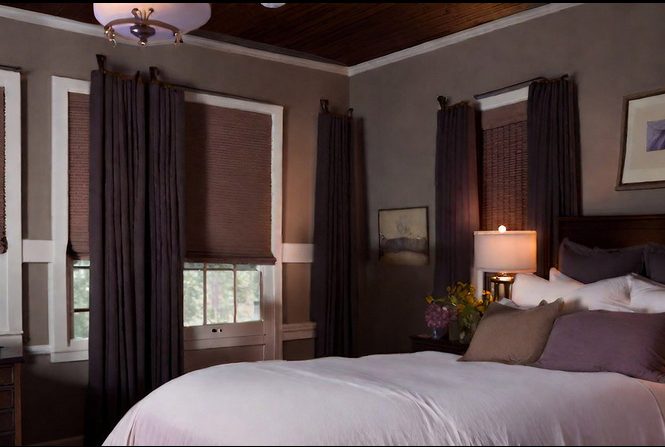
Your babies need plenty of sleep, so consider how much natural light you want to sail into your nursery during nap times.
Blackout Feature
Blackout curtains, blinds, or shades can be a good choice to block out light and create a cozy, peaceful, and calming environment. When choosing a window treatment to decorate a nursery, bear in mind that putting your baby down can be exhausting. It can be difficult for both you and your baby to put the baby to sleep. Window treatments should block out light and noise from the outside. Therefore blackout roman shades are a great choice. Thermal liners are also an option for better insulation.
Material and Stuff
Consider the material and stuff of the nursery window treatments. Organic fabric materials, such as cotton or bamboo, are often a good choice for nurseries as they are soft, gentle, and durable.
Style
Think about the overall style of the nursery room in your home and choose window treatments that perfectly complement it. You may choose a pattern or color that coordinates with the bedding or other home interior décor style.
Fabric Choices

When buying window treatments for a baby’s nursery, choose fabrics that are safe for small fingers. Avoid floor-length draperies, which can be dangerous for crawling babies. Tension rods are too low for infant tugging. Choosing fabric-based shades is safer than woven wood shades. Also, don’t choose embellished curtains or blinds.
Convenience and Cost of Maintenance
Choose window treatments for your baby’s room that are easy to clean and maintain. For example, you can quickly and easily wipe down any spills or messes on a dust-resistant material.
Functional Diversity
When choosing the best window treatments for a nursery, consider their functional potential. For example, cellular shades for kids’ rooms can provide you with light control, light filtering, privacy, blackout, and energy efficiency.
Energy Efficiency
Choosing energy-efficient window covering can help you regulate the temperature in the nursery. It is especially important during extreme weather conditions. Look for options that insulate the room and keep the heat or cold out.
Temperature Regulation
Choosing the correct type of shade for your child’s nursery is critical for ensuring that the room is cool enough to avoid a heat-related illness or even SIDS, the most common form of infant death in the US. Window treatments should reflect sunlight and keep the temperature at a comfortable level for baby’s sleep hours. They also protect furniture. The right window treatment can also help to prevent glare from the outside and reflect heat.
Size of Window Frame
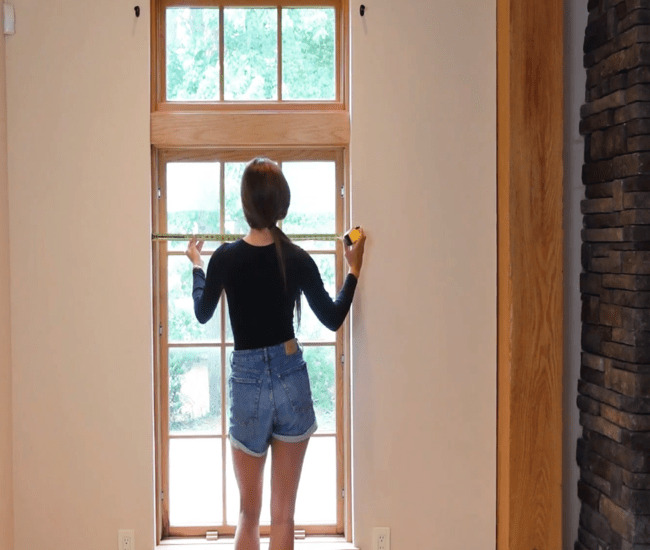
You should be sure to consider the size of the window shade and how it will affect the privacy of your child. Once you have determined the size of your window, you can start to choose the right window treatment. The right window coverings can make your room more functional and attractive.
Convenient DIY Installation
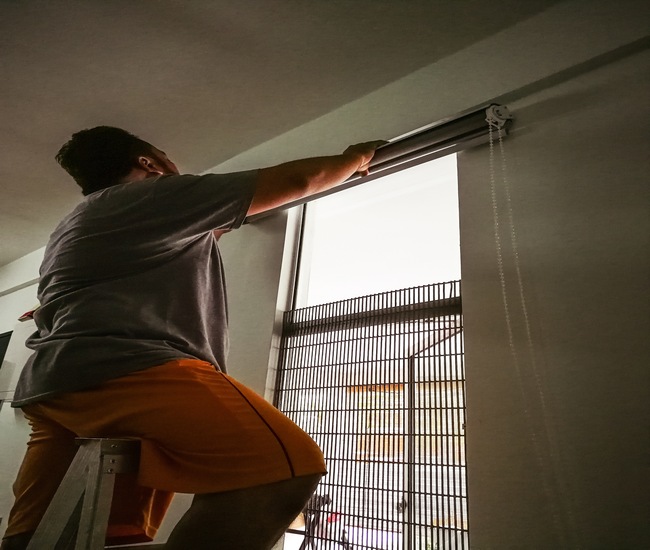
Easy DIY installation is one of the factors to consider when choosing the best window treatments for a nursery. Fixing such window coverings will only require attaching mounting brackets to the window frame or the wall around it.
Ease of Operation
The best window treatments for a nursery will also provide hassle-free and easy operation. Top-down, bottom-up shades can be easily lowered, raised, and adjusted for the required amount of light and privacy with one hand.
Cleaning and Maintenance
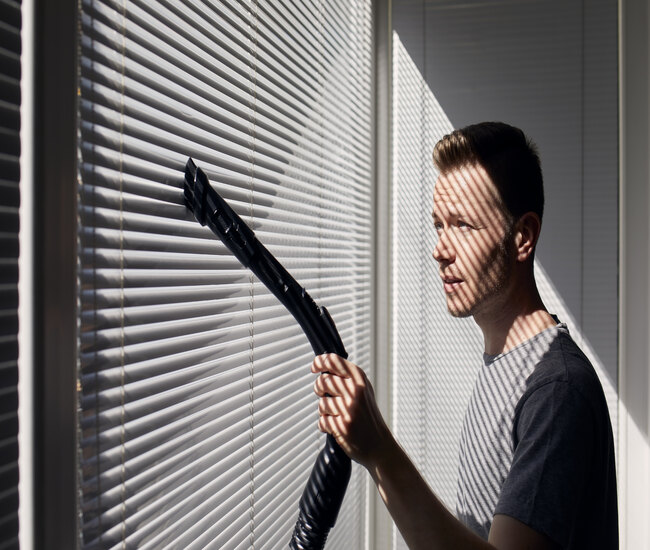
Although experts differ on how to care for the best window treatments for a nursery, most recommend regular vacuuming and dusting. Regular vacuuming is essential because dust tends to settle in pleats and gathers. Also, you may choose to dry clean your best window treatments for a nursery.
By paying heed to these factors, you can choose the best window treatments for a nursery that will create a safe, comfortable, cozy, and aesthetically appealing space for your baby to rest and play.
Different Types of Best Window Treatments for a Nursery
While the best window treatments for a nursery are available in lots of styles and functional potentials, you need to choose the one that provides the required functionality and perfectly blends with your nursery’s interior décor style.
Below are some of the options to choose from.
Roller Shades – An Sleeker, Safer, More Versatile Window Treatment for Kids Room
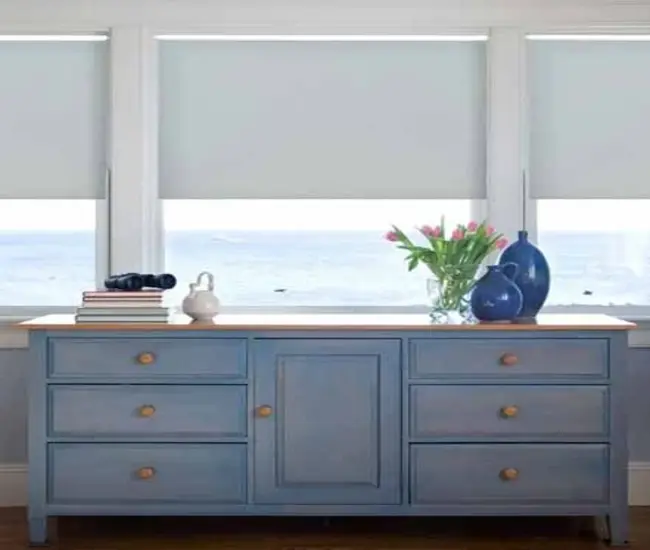
There are many options when it comes to window treatment for your baby’s nursery. Among these are roller blinds and shades, which are available in different fabrics and styles.
Pros
- A sleeker, kid-friendly window treatment option.
- Simple, affordable blind.
- Available in lots of fabric colors, patterns, and styles to suit your nursery’s decor.
- Blackout roller shades can darken the nursery room for your baby’s restful sleep.
- Cordless, totally child-safe design.
Cons
- Will flap in the breeze and disrupt your baby’s sleep if the window is open.
- If you choose double roller blinds, they’ll be much costlier.
Blackout Shades – The Best Option to Control Light in Nursery
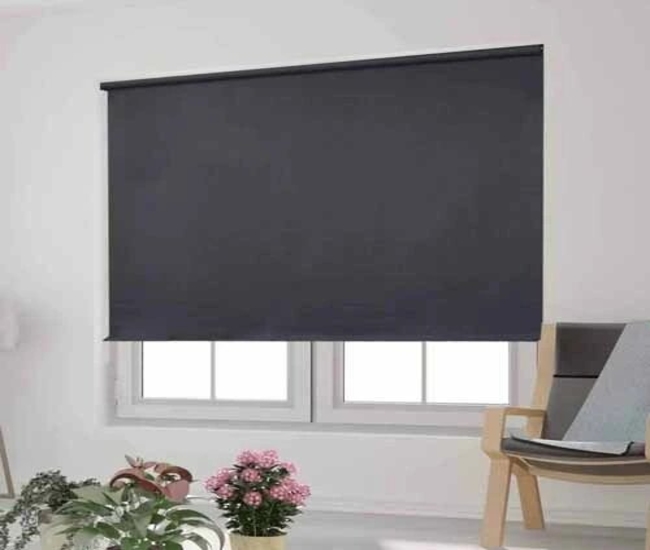
Blackout shades can be a great option if you’re trying to keep the room dark and cool. Also, if you need complete control over the light, blackout window treatments may be an option.
Pros
- They are a fantastic option to prevent light from entering the nursery.
- Best choice for kids who have light sensitivities.
- Can help you save energy.
Cons
- Limited style options.
- May totally rob your toddlers of daylight.
Cellular Shades to Block Sun, Heat, & Noise
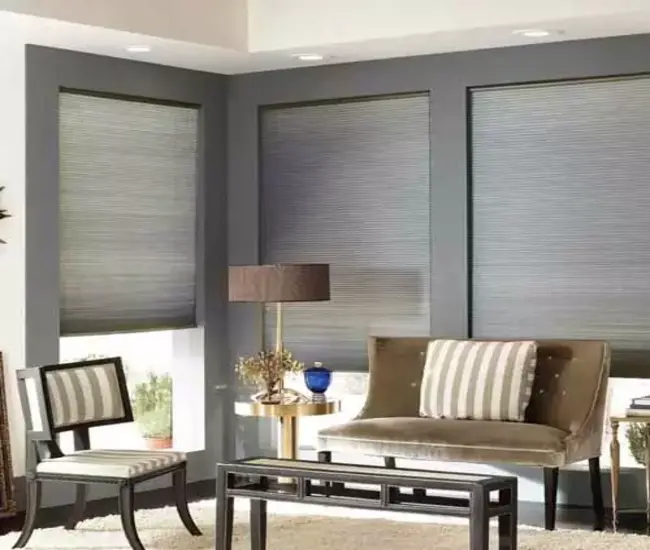
Honeycomb or cellular shades can be used to provide privacy and insulate your windows. They come with options for light-filtering or total sunlight blockage. Honeycomb shades are great for the nursery because they can roll from the top or bottom to allow light in or block the sun completely. This allows you to control light and opacity, while also keeping heat out of the room. They can be paired with window-length curtains.
Pros
- Insulate your baby’s room against summer heat and winter cold.
- Available with light filtering design to allow better light regulation.
- Offer different light control opacities
- Their solid construction provides fantastic privacy.
Cons
- A bit harder to clean
- Offer less lighting control than window blinds
Roman Shades with Beautiful Patterns to Create a Dramatic Statement in a Nursery
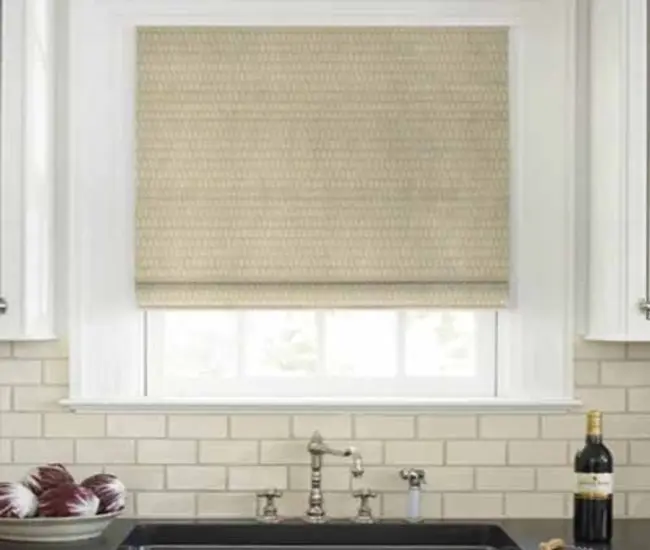
When choosing Roman shades for a nursery, you can customize the look of the window treatment, ranging from the colors to the styles. You can show off the architectural details and hide the less-than-attractive ones by installing them on the windows’ outside. They can also help make a window appear bigger.
When considering which style to buy, consider the durability of the fabric and the potential for damage if you’re buying a pair for a toddler’s room.
Choose patterned Roman shades for a dramatic statement or choose simple shades without distracting from other design elements. You have the option of choosing between motorized and cordless shades. They offer different levels of privacy.
Pros
- Roman shades can be cordless or motorized, depending on the mounting style.
- There are many styles of Roman shades that can be used in a nursery.
- You can choose between a simple flat-fold shade or one with a more complicated curved fold.
- They can add a luxurious touch to any room for babies.
Cons
- Unlink vertical blinds or venetian blinds, you cannot tilt Roman shades open or close.
- Not suitable for high moisture areas.
Solar Shades to Save Kid’s Skin and Furniture from Sun Damage
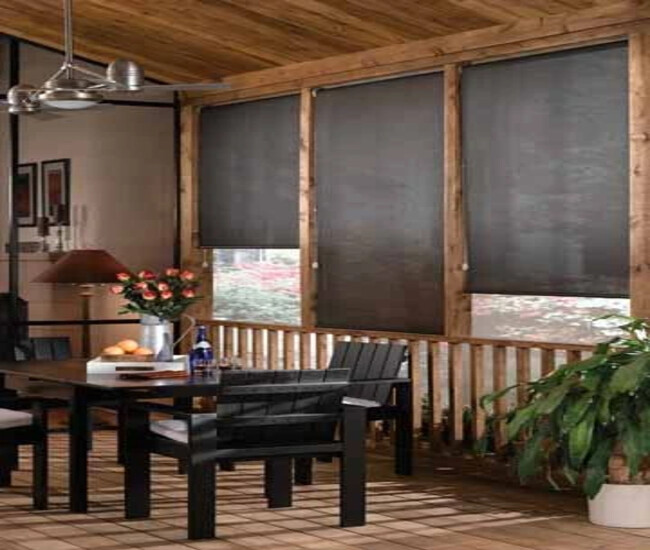
Sunlight rays from the sun can bleach fabrics and break the chemical bonds of dyes. These rays also make textiles break and become brittle. Consider solar shades with blackout roller shades if privacy is a concern. Pros
- Solar shades not only block sunlight but also offer privacy for your baby.
- Add visual appeal to a nursery’s interior.
- Easy to retract or lower as the day passes.
Cons
- Limited design options
- Not effective at keeping heat outside
Custom Window Treatments
Custom window treatments are a great way for your nursery to remain cool and comfortable for your child. You can find solar shades for nursery windows and other window treatments in all shapes and sizes at affordable prices. You can also choose the fabric that best matches your nursery’s theme.
Pros
- Custom-made nursery window coverings will fit perfectly into your window size, space, & decor.
- They’ll last many more years than ready-made blinds.
- Coordinate well with your kid’s room’s decor.
Cons
- More expensive option
- They require more time in manufacturing
Drapery Fabric Panels
When purchasing drapery fabrics for your nursery window treatments, make sure to consider the lining, which not only adds strength to your panels but also protects them from direct sunlight. The lining will prevent fading and make your drapes more comfortable and energy-efficient. The lining is available in various materials, including cotton and polyester blends. The standard liner is a blend of cotton and polyester that will give your panels greater stiffness and protection against direct sunlight.
You can choose a Victorian or pleated design if you prefer a more traditional look. Drapery panels can be pinned with rod hooks that are two inches apart. There is a wide range of fabrics in all styles and colors.
Pros
- A wide range of textures and weaves to choose from
- Affordable pricing
- Easy to maintain in a nursery
Cons
- Drapery fabric panels wrinkle easily
- Offer limited insulation
Frequently Asked Questions about Best Nursery Window Treatments
Are curtains or blinds better for nursery?
Blinds are a better option for nursery if kids suffer allergies, as thick fabric curtains would collect dust, dirt, dust mites, and pollen. Choose cordless spring-loaded or motorized roller blinds to remove the risk of strangulation posed by lift cords.
Is it safe to put curtains in a nursery?
The answer is conditionally ‘yes’. Corded, floor-length drapes pose a strangulation hazard for infants and toddlers. A child may get trapped in floor-length curtains or drapes when pulling them off the wall. So, when putting curtains in a nursery, always choose cordless Roman curtains and keep the bottom rail 2 to 3 feet above the floor.
What type of curtains for a nursery?
We highly recommend demount or blackout curtains made of thick fabric with less than 1% openness. They will effectively block out the glaring sunlight late in the morning. Blackout curtains will also cancel noise and reduce heat.
Can you mix curtains and blinds in the same room?
The answer, for the most part, is ‘yes!’ especially when you are covering windows in a nursery. When paired, curtain and blinds will bring out a flexible decor and ensure adequate blocking of external light, noise, and privacy control. Also, mixing curtains and blinds will add extra depth and elegance to the nursery windows.
Need More Help?
Still need information about the design, functionality of the best blinds, shades, and curtains for a nursery? Get in touch for help now! Use 24/7 live chat or give us a call at (800) 863-6109 to contact our design experts for custom solutions.
